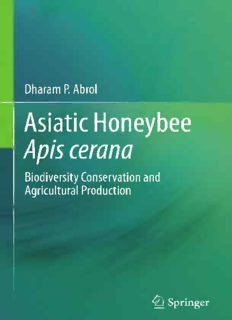Table Of ContentAsiatic Honeybee Apis cerana
Dharam P. Abrol
Asiatic Honeybee
Apis cerana
Biodiversity Conservation and Agricultural
Production
2123
Dr.DharamP.Abrol
DivisionofEntomology,
Sher-e-KashmirUniversity
ofAgriculturalSciences&Technology
ofJammu,Jammu
JammuandKashmir,India
ISBN978-94-007-6927-4 ISBN978-94-007-6928-1(eBook)
DOI10.1007/978-94-007-6928-1
SpringerDordrechtHeidelbergLondonNewYork
LibraryofCongressControlNumber:2013941730
© SpringerScience+BusinessMediaB.V.2013
Nopartofthisworkmaybereproduced,storedinaretrievalsystem,ortransmittedinanyformorby
anymeans,electronic,mechanical,photocopying,microfilming,recordingorotherwise,without
writtenpermissionfromthePublisher,withtheexceptionofanymaterialsuppliedspecificallyfor
thepurposeofbeingenteredandexecutedonacomputersystem,forexclusiveusebythepurchaser
ofthework.
Printedonacid-freepaper
SpringerispartofSpringerScience+BusinessMedia(www.springer.com)
Dedicatedto,almightyGodforgrantingme
life,strengthandholdingmyhandtoreach
whereIstandnow,tomyparentsfortheir
eternalblessingfromheaven.TomyGuru
LateProfessorR.P.Kapil—anexcellent
scientistandsplendidpersonwhointroduced
metothefascinatingworldofhoneybees.
TomywifeProfessorAsha—forherenduring
love,encouragement,supportandgifted
senseofhumor.TomydaughterVitastaand
sonRajatfortheirrevolutionary
andinnovativeideas.
Foreword
The world is facing food deficit that is exacerbated by escalating prices, coupled
with instability of climatic cycles. The growing population pressure has hastened
the environmental degradation, ultimately posing a threat to natural resources and
fastapproachingfamine. Inthenext50years, theglobalpopulationisexpectedto
reach9billion;thusdoublingthefood,feedandcropdemand.Concomitantly,this
situationhasfurtheraggravatedbecauseofpollinatordeclineworldwideresultingin
pollinationcrisis.Theseproblemshavebeenfurtheraidedandabettedbyalackof
prophylacticprogressintheconservationofbiodiversityandincreasedagricultural
production.
Amongstpollinators,honeybeesaredecliningatalarmingrate.TheEuropeanhon-
eybeeApismelliferaisawell-studiedinsect.OntheotherhandtheAsiatichoneybee
Apisceranawhichhasprovidedmankindwithinvaluableproducts,conservationof
naturalresourcesandpollinationofagriculturalcropsisrelativelylittleunderstood.
Itisthemostvaluablenaturalresourceofbeekeepingandhasbeenconsideredavital
component of the natural ecosystem, well adapted to the local climatic conditions
andfloralresourcesthroughcenturiesofnaturalselection.Despiteitseconomicuse-
fulness,biodiversityofAsianhivebeeA.ceranaissufferingprecipitousdeclineand
isthreatenedwithextinctioninitsentirenativehabitat.
Topromotebeekeepingasasustainableoptionforruraldevelopment,cropproduc-
tionandbiodiversityconservation,thereisanurgentneedtogenerateinformationon
thisimportantspecies.Althoughanumberofpublicationshaveappearedonhoney-
beesinthemarket,noattempthasbeenmadetoapproachthesubjectinasystematical
andacomprehensivemannerincaseofA.cerana.Althoughabriefperusalofthe
studiesonA.ceranaatthewebsiteGooglescholarshowsthatduringthelastcentury
thepublicationofresearchpapersinthisareahasgrownexponentially,andinjustthe
lastdecade,some5,000itemshaveappeared.Intheevent,itisbothfairandpertinent
toask:“IsthereactuallyaneedforyetanotherworkonTheAsiaticHoneybeeApis
cerana: The Conservation of Biodiversity, andAgricultural Production”? The an-
swerisyes.Asvoidexistsondifferentfacetsofbiologicalconservation,agricultural
productionandroleofA.ceranainimprovingfoodsecurityandlivelihoods.Profes-
sor Dharam P.Abrol attempts to fill this gap by providing detailed information on
vii
viii Foreword
differentaspectsofA.ceranaleadingtobiodiversityconservationandsustainability
offoodproduction.
The history of beekeeping with A. cerana inAsia is at least as ancient as that
ofbeekeepingwithA.melliferainsouthernEuropeandtheMiddleEast.A.cerana
andA.melliferaaretworelatedspeciesofcavity-nestinghoneybeesthatarethought
to have diverged 2–3 million years ago. Each species can decode the information
containedinthewaggledancesoftheother.A.ceranaascomparedwiththeEuropean
honeybeeA.melliferaforagesonawidevarietyofresources.Eventheresourcesthat
provide small quantities of rewards are worked upon resulting in outcrossing of a
largespectrumofcropsandwildflowers.
ThepopulationofA.ceranaandotherpollinatorsaredecliningatanalarmingrate
thathasthreatenedtheexistenceofplantlifeandthisdownwardtrendcoulddamage
dozensofcommerciallyimportantcrops.Adeclineinpollinatorpopulationsisone
form of global change that actually has credible potential to alter the shape and
structureofterrestrialecosystems.Thedeclineinpollinatorpopulationanddiversity
presentsaseriousthreattoagriculturalproduction,conservationandmaintenanceof
biodiversityinmanypartsoftheworld.
A. cerana is a species that has shown great adaptive potential, as it is found
almosteverywhereinhighlydiverseclimates.Thereisenoughevidencetosuggest
thatenvironmentalchangeshaveadirectinfluenceonhoneybeedevelopment.Asian
honeybeeA.ceranacandefendattackofenemieswiththeuseofvariousweapons
includingstings,mandibles,legsandwings—variouslyusedtograsp,pull,biteand
sting. The outstanding effectiveness of nest defense in honeybees is not so much
basedonthefacultiesofindividualbees,butonthesocialcoordinationofthousands
ofindividuals.
Interspecific competition for a limited resource can result in the reduction of
survival, growth and/or reproduction in one of the species involved. Likewise, in-
troduction of A. mellifera eliminated A. cerana japonica in China and Japan and
A.ceranaindicainIndiansubcontinentincludingIndia,Pakistan,Nepal,Bangladesh
andotherneighbouringcountries.Negativeimpactsofalienbeesneedtobecarefully
assessedbeforefurtherintroductionsarecarriedout.Themainobjectiveofthisbook
istoencouragebeekeepinginterventionshelpingpeopletostrengthenlivelihoodand
ensuremaintenanceofhabitatandbiodiversity.Thisis,indeed,anawesometaskand
wemustcongratulateProfessorDharamP.Abrolforbringingoutthisbookforthe
benefitoftheglobalcommunity.
Dated21,March2013 Prof.Dr.MichalWoyciechowski
Preface
Asiatic honeybee Apis cerana, are small honeybees of southern and southeastern
Asia such as China, India, Japan, Malaysia, Nepal, Bangladesh and Papua New
Guinea.ThisspeciesisthesisterspeciesofApiskoschevnikovi,andbothareinthe
samesubgenusastheEuropeanhoneybee,Apismellifera.Forages,coloniesofthe
oriental honeybee A. cerana have provided mankind with honey and beeswax, as
well as furnishing invaluable service in the pollination of agricultural crops. This
bee’srangeofdistributionisfargreaterthanthoseofA.floreaandA.dorsata:itis
foundthroughoutthetropical, sub-tropicalandtemperatezonesofAsia, occurring
in the Indian sub-continent and Sri Lanka in the west, through SoutheastAsia, to
IndonesiaandthePhilippinesintheeast. Furthernorth, itisfoundinthesouthern
USSRandChina,throughtheKoreanpeninsula,toJapan.Thiswiderangehasled
toimportantvariationsamongstthebee’sgeographicalraces: particularlybetween
the tropical and temperate races, there are wide differences in workers’body size,
nest size, colony population, swarming and absconding behaviour. The temperate
and sub-tropical races appear to store greater quantities of food than the tropical
races, which in turn are more mobile than the former, tending to swarm, abscond
andmigratequitefrequently.Furthermore,A.ceranaisadeptincollectingsporadic
nectar flowers in disturbed or extensively modified habitats in the mountain and
forestregionandcanthermoregulatebetween33and35.5◦Cinatemperaturerange
of12–36◦C.
A.cerana,theindigenoushivebeeofAsia,isthemostvaluablenaturalresourceof
beekeepingandhasbeenconsideredavitalcomponentofthenaturalecosystem.Itis
welladaptedtothelocalclimaticconditionsandfloralresourcesthroughcenturiesof
naturalselection.Ithasbeenreportedtobeanexcellentpollinatorofcropsthatbloom
inearlyspringsuchasalmonds, apples, pears, plumsanddifferentvegetableseed
crops.Beekeepersandpollinationscientistshavebeenexperiencingrapiddeclinein
A.ceranapopulations,whichmayresultinthelossofplantbiodiversityinanarea
andcreatesocio-economicproblems.BecauseofthedeclineofA.ceranacolonies
inmanyregionsofAsia,A.ceranaisanendangeredspecies.Thesmallerthenative
populationofA.ceranainanyarea,thehigherthedangerforthisbeebecauseofits
mating behaviour. When theA. cerana population is destroyed, a native and well-
adaptedpollinatorforbothnativeandagriculturalplantswillbelost.Theresultsfor
ix
x Preface
lossofnativeplantbiodiversityandthepollinationofagriculturalcropscannotbe
estimatedbecauseA.melliferaisnotabletopollinateaseffectivelyasA.cerana?
A.ceranaoffersseveralcomparativeadvantagesoverA.melliferaaspollinator.
These include initiation of early foraging at lower temperatures, longer foraging
hours,shorterflightrange,nocompetitionforfoodandnestingsiteswithotherbee
species, co-evolution with native crops, more suitable for glass house pollination,
better searching ability for sparse floral resources. Moreover, this bee species is
more docile and industrious in nature, less prone to attacks of wasps, and a high
level of resistance to nosema disease and parasitic mites. A. cerana can coexist
with other native bee species and require little chemical treatment of colonies to
controlepidemics.However,asyet,thisnativebeespecieshasnotbecomepopular
amongst beekeepers because of several behavioural characteristics. These include
theirfrequentswarmingandabsconding,theirtendencytorob,theirproductionofa
largenumberoflayingworkers,andtheirlowerhoneyyields.Thesenegativetraits
showeco-geographicalvariationsdependinguponthesub-species/geo-ecotypesand
managementefficiencyofthebeekeepersandareamenablethroughbasicandaction
research.
Despite its economic usefulness, biodiversity of Asian hive bee A. cerana is
suffering precipitous decline and is threatened with extinction in its entire native
habitat. For example, in Japan, beekeeping with this native bee species has been
completelyreplacedbyEuropeanhoneybee,A.melliferaandonlyafewbeekeepers
and research institutes are raising A. cerana colonies. In China, out of more than
8.5millioncoloniesofbeeskeptinmodernhive,70%areexoticA.mellifera.Simi-
larly,inSouthKorea,only16%beekeepingiswithnativeA.ceranaandremaining
hasbeenreplacedbyexoticA.mellifera.SimilarlyinIndia,only10%ofbeekeeping
isdonewithA.cerana.
Duringthepastfourdecades,humanpopulationhasincreasedmorethantwofolds
exertingatremendouspressureonthenaturalresourcesandthelandespeciallyfor
food,fuelandtimber.Asaconsequence,vastforestshavebeenconvertedintoagri-
culturallandandmountainshavebecomebarrenduetoruthlesscuttingsandgrazing,
thusextensivelydestroyingthefoodandhabitatofseveralpollinatorsspecies.Along
withthese, useofchemicals, too, havegreatlywipedoutthepopulationofnatural
pollinators,thusresultinginfailureofreproductioninseveralcross-pollinatedplant
speciesincludingtheagriculturalcrops.ThisbookonA.cerana,addressestwobasics
questions.HowtheA.cerana,canbeutilizedintheconservationofplantspecies?
HowtheAsiatichoneybeeA.cerana,canbeutilizedforsustainableagricultureand
securinglivelihoodwithoutdisturbingtheenvironmentandthenaturalbalance?
This book emphasizes conserving and culturingAsiatic honeybee A. cerana. It
providescompleteinformationonallaspectsofA.ceranabeekeeping.Itisfirstofits
kindwhichdealsindetailsonbiology,biogeography,reproduction,genetics,molec-
ular phylogeny, interaction with other species, floral resources, dance language,
safetyfrompesticides,managementproblems,lossofgeneticdiversity,behavioural
defence,roleinfoodproduction,livelihoodsecurityandconservationstrategiesfor
Preface xi
protectingbiodiversityandenhancingcropproductivity.Despiteitseconomicuse-
fulness,biodiversityofAsianhivebeeA.ceranaissufferingprecipitousdeclineand
isthreatenedwithextinctioninitsentirenativehabitat.
To promote beekeeping as a sustainable option for rural development, crop
productionandbiodiversityconservation,thereisanurgentneedtogenerateinfor-
mationonthisimportantspecies.Althoughanumberofpublicationshaveappeared
on honeybees in the market, no attempt has been made to approach the subject in
systematically and in a comprehensive manner in case of A. cerana. The aim of
thisbookistofillthegapbyprovidingdetailedinformationondifferentaspectsof
A. cerana leading to sustainability and environmental protection. The compilation
ofthisbookisuniqueinthesensethatinthecontextofpollinatordeclineoverthe
world,conservationofthisspecieswillbeastepforsustainingfoodsecurity.
A vast spectrum of people has helped in one way or the other in the writing of
thisbook,whichwouldhaveremainedadistantdreamwithouttheiractivehelpand
support.Thisbookistheoutcomeofmypersonalexperiencesandthecontributions
ofseveralworkerswhichhavebeenincorporated.Iexpressmyhumbleandprofound
thanktoallofthemwhosehardworkhasenabledmetocompilethesuitableinfor-
mation in a such a manner that it would be useful to those interested in basic and
appliedpollination.Theillustrationsandfiguresareeitheroriginalorredrawnfrom
other sources which have been cited individually in the figure legends.All the au-
thorswhoseworkhasbeenused/refereeddeservespecialappreciationandheartiest
acknowledgmentsandif,anyomissionhascreptanywhereIshallberesponsibleand
apologizeinadvance.
I am particularly thankful to Professor Dr. Raghavendra Gadagkar, Centre for
EcologicalSciences,IndianInstituteofSciencesBangalorewhohasalwaysbeena
sourceofinspiration,neededhelp,guidanceandencouragement.Ithankmyuniver-
sityauthoritiesfortheexcellentworkingatmosphereandneededencouragementfor
compiling such a voluminous book. Dr. Uma Shankar deserves special apprecia-
tionforredrawingmanyofthelinedrawings.Dr.DebjyotiChaterjeeneedsspecial
mention for painstaking job of preparing index. I am also extremely thankful to
ZuzanaBernhartSeniorPublishingEditorandElisabeteMachadoEditorialAssis-
tantofSpringerwhotookgreatpainsandkeeninterestinpublicationofthisbookin
averyimpressiveway.WordsareinsufficienttoexpressmygratitudestoDr.D.K.
AroraHon’bleVice-chancellorforhisencouragementandinspiration.
Lastbutnottheleast,mysincerethanksareduetomywifeProfessorDr.Asha
Abrol, daughter Er. Vitasta and son Er. Rajat for their endurance and help while
writingthisbook.
Jammu,March31,2013 DharamP.Abrol
Description:The world is facing food crisis as the growing human population is posing a threat to natural resources and fast approaching famine. In the next 50 years, the global population is expected to reach 9 billion doubling the food, feed and crop demand. Concomitantly, this situation has further aggravate

